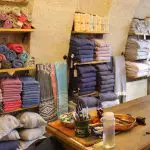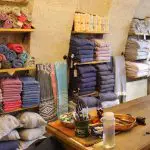If you're curious about whether rayon fabric is sustainable, it's like peeling back the layers of an onion to understand its environmental impact.
Rayon, often likened to silk for its smoothness, is a semi-synthetic fabric made from natural materials like wood pulp.
Understanding the sustainability of rayon involves examining its production process, resource utilization, and biodegradability.
By comparing rayon with other fabrics and exploring sustainable practices in its production, you can make informed choices about its environmental impact.
This exploration will provide you with a clear understanding of the complexities surrounding the sustainability of rayon fabric, empowering you to make environmentally conscious decisions.
Key Takeaways
- Rayon fabric is breathable, comfortable, and has a good drape, making it suitable for a wide range of clothing items.
- Rayon production can have a negative environmental impact due to the use of chemicals and large amounts of water, but advancements in production techniques and the use of sustainably sourced materials can mitigate this.
- The production process of rayon, particularly chemical wood pulping, can release harmful pollutants into the environment and contribute to water pollution.
- Rayon production involves substantial water and energy consumption, which strains local resources and contributes to carbon emissions. Reducing water and energy usage in rayon production is crucial for sustainability.
What Is Rayon Fabric
Rayon fabric is a semi-synthetic textile made from regenerated cellulose fibers. It possesses several properties that make it a popular choice in the textile industry. Rayon is breathable, comfortable, and has a good drape, making it suitable for a wide range of clothing items such as shirts, dresses, and linings. It also takes dye well, resulting in vibrant and colorfast garments. Moreover, rayon has moisture-wicking properties, making it an ideal choice for summer clothing. On the downside, rayon fabric is prone to wrinkling and requires delicate handling during washing and ironing.
In terms of environmental impact, rayon production involves the use of chemicals and large amounts of water. The process of creating rayon from wood pulp or bamboo can result in pollution if not properly managed. However, advancements in production techniques have led to the development of more eco-friendly methods, such as the closed-loop process, which recycles the chemicals and solvents used. Furthermore, the use of sustainably sourced wood and bamboo for rayon production can mitigate its environmental impact.
The Production Process of Rayon
When it comes to the production process of rayon, it's important to consider:
- The method of chemical wood pulping
- The environmental impact assessment
- The water and energy usage involved
Understanding how rayon is produced can shed light on its sustainability and environmental implications. By examining these points, you can gain insight into the complexities of rayon production and its potential impact on the environment.
Chemical Wood Pulping
The chemical wood pulping process is a crucial step in the production of rayon, as it transforms cellulose from wood into a soluble form for further processing. This process involves the use of chemicals to break down the wood pulp and extract the cellulose, which is then used to create rayon fibers.
It's important to note that this method has raised concerns about environmental impact and sustainability. Some key points to consider are:
- Chemical wood pulping can result in the release of harmful pollutants into the environment.
- The use of large amounts of chemicals and water in this process can contribute to water pollution.
- Chemical recycling methods are being explored as potential sustainable alternatives to traditional wood pulping processes.
- Sustainable alternatives, such as eco-friendly solvents and closed-loop systems, are being developed to minimize the environmental impact of rayon production.
Environmental Impact Assessment
Assessing the environmental impact of rayon production is essential to understanding its sustainability. The production process involves chemical wood pulping, which has significant environmental implications. It contributes to deforestation and the release of harmful chemicals into the environment. This raises concerns about habitat destruction and loss of biodiversity, particularly when wood pulp is extracted from ancient and endangered forests. Additionally, the chemicals used in the pulping process, such as carbon disulfide, can pose risks to both environmental and human health.
Sustainable alternatives like lyocell (Tencel) and modal offer more eco-friendly options. These alternatives utilize wood pulp from responsibly managed forests and employ closed-loop production processes. By using responsibly sourced materials and minimizing chemical waste, these alternatives help reduce the environmental impact of rayon production.
To promote sustainable practices, consumer awareness of these environmental impacts is crucial. By understanding the consequences of rayon production, consumers can make informed choices and demand more sustainable and ethical practices within the industry.
Water and Energy Usage
To understand the sustainability of rayon fabric, you need to consider the significant water and energy usage involved in its production process. The production of rayon involves substantial water consumption and energy usage, which can have environmental implications. Here are some key points to consider:
- The water-intensive nature of rayon production can strain local water resources.
- Energy consumption during the production process contributes to carbon emissions and overall environmental impact.
- Reducing consumption of water and energy in rayon production is crucial for sustainability.
- Exploring eco-friendly alternatives to the traditional production methods can mitigate the environmental impact of rayon fabric.
Understanding the water and energy usage in rayon production is essential for making informed decisions about sustainable fabric choices.
Environmental Impact of Rayon Production
When it comes to the environmental impact of rayon production, it's important to consider the significant chemical usage involved in the manufacturing process.
Additionally, the sourcing of wood pulp for rayon production has been linked to deforestation, posing a threat to natural ecosystems.
These factors contribute to the overall environmental footprint of rayon fabric and are important considerations when assessing its sustainability.
Chemical Usage in Production
You may be surprised to learn that the production of rayon fabric involves the extensive use of chemicals, which has a significant environmental impact.
- Chemical alternatives: Manufacturers are exploring eco-friendly alternatives to the traditional chemical processes used in rayon production.
- Water pollution: The chemical runoff from rayon production can contaminate water sources, posing a threat to aquatic ecosystems and human health.
- Air pollution: The release of chemicals into the air during rayon production contributes to air pollution, impacting both environmental and human well-being.
- Deforestation: Some rayon production methods rely on wood pulp from trees, leading to deforestation and habitat destruction.
These environmental concerns highlight the need for sustainable practices and the development of more eco-friendly processes in the production of rayon fabric.
Deforestation for Sourcing
As deforestation is a significant concern in the sourcing of rayon fabric, it's crucial to understand its environmental impact.
The production of rayon often involves the harvesting of trees, which can lead to deforestation and habitat loss. This has a direct impact on biodiversity and contributes to climate change.
The deforestation impact of sourcing rayon raises concerns about its sustainability. It's important to consider sustainable alternatives such as sourcing rayon from responsibly managed forests or using alternative materials like lyocell, a form of rayon that's derived from sustainably sourced wood.
Additionally, promoting the use of recycled rayon can also help reduce the demand for virgin wood pulp, thereby mitigating the environmental impact associated with deforestation for rayon production.
Resource Utilization in Rayon Production
The production of rayon fabric requires the utilization of various natural resources and chemical inputs. Resource utilization in rayon production plays a significant role in determining its environmental impact and resource efficiency.
Here's a breakdown of the resource utilization in rayon production:
- Water: The production of rayon fabric involves significant water usage, often leading to water pollution and depletion of freshwater resources.
- Chemicals: Harsh chemicals such as carbon disulfide, sulfuric acid, and chlorine are utilized in the production process, posing risks to both human health and the environment.
- Energy: The manufacturing of rayon requires substantial energy input, contributing to greenhouse gas emissions and overall energy consumption.
- Wood Pulp: The sourcing of wood pulp, primarily from trees, contributes to deforestation and habitat destruction, impacting biodiversity and ecosystems.
It is crucial to consider the resource utilization in rayon production to address its environmental impact and work towards more sustainable practices.
Biodegradability of Rayon
When considering the biodegradability of rayon, it's important to understand its potential environmental impact and decomposition process.
Rayon is a semi-synthetic fabric made from natural sources such as wood pulp, making it biodegradable under the right conditions. However, the biodegradability of rayon can vary depending on the specific type of rayon and the environment in which it's placed.
Environmental impact assessments have shown that rayon, while biodegradable, may still contribute to pollution if not disposed of properly. Sustainable practices such as proper waste management and recycling can minimize the environmental impact of rayon fabrics.
Additionally, advancements in technology have led to the development of more eco-friendly production processes for rayon, further improving its biodegradability and overall sustainability.
As consumer awareness of environmental issues continues to grow, the demand for biodegradable and sustainable fabrics has increased. This has led to a greater focus on improving the biodegradability of rayon and implementing responsible resource utilization throughout its lifecycle.
Comparing Rayon With Other Fabrics
To assess the sustainability of rayon fabric, consider comparing its biodegradability, production methods, and environmental impact with those of other fabrics. When comparing sustainability, it's important to evaluate the environmental impact of rayon fabric production, the biodegradability of the fabric, and the availability of sustainable alternatives in the market.
Here are some key points to consider:
- Environmental Impact: Rayon production involves the use of chemical solvents and large amounts of water, which can lead to environmental pollution. Comparatively, some eco-friendly textiles like organic cotton and hemp have lower environmental impact due to their less intensive production processes.
- Biodegradability: Rayon is biodegradable, which is a positive for its end-of-life impact. However, some natural fibers like linen and Tencel (made from sustainably sourced wood) are also biodegradable and have less environmental impact during production.
- Sustainable Alternatives: When considering sustainable alternatives to rayon, fabrics like bamboo, organic cotton, and hemp are gaining popularity due to their eco-friendly production methods and biodegradability.
- Eco-Friendly Textiles: It's essential to explore the availability and benefits of eco-friendly textiles like Tencel, Modal, and recycled polyester, which offer sustainable options for environmentally conscious consumers.
Sustainable Practices in Rayon Production
Considering sustainable practices in rayon production, you can implement closed-loop systems to minimize chemical waste and water usage. By doing so, you contribute to reducing the environmental impact of rayon production. Additionally, ethical sourcing of raw materials is crucial to ensure the sustainability of rayon fabric. It is important to source wood pulp from responsibly managed forests or utilize alternative sustainable sources such as bamboo. Carbon footprint reduction is another key aspect to focus on. Adopting energy-efficient manufacturing processes and utilizing renewable energy sources can significantly lower the carbon footprint associated with rayon production.
| Sustainable Practice | Description | Benefits |
|---|---|---|
| Closed-loop Systems | Minimize chemical waste and water usage | Reduces environmental impact |
| Ethical Sourcing | Responsibly source raw materials from sustainable sources | Ensures sustainability of rayon fabric |
| Carbon Footprint Reduction | Implement energy-efficient processes and renewable energy | Lowers the carbon footprint |
Implementing sustainable practices in rayon production is not only beneficial for the environment but also aligns with the growing consumer demand for ethically produced textiles.
Conclusion: Making Informed Choices
You can make informed choices by considering the sustainable practices in rayon production, ensuring that your purchases align with ethical and environmentally friendly standards. When making decisions about rayon fabric, it's important to understand your role in ethical sourcing and consumer responsibility.
Here are some key points to consider:
- Transparency: Seek brands and manufacturers that openly share information about their sourcing and production processes. Transparency builds trust and allows you to make informed decisions.
- Environmental Impact: Consider the environmental footprint of the rayon fabric you purchase. Look for certifications or labels that indicate sustainable practices, such as eco-friendly dyes and responsible water usage.
- Social Responsibility: Support brands that prioritize fair labor practices and ethical treatment of workers throughout the supply chain. Your choices can positively impact the lives of those involved in rayon production.
- Longevity: Prioritize quality and durability when making purchases. Investing in long-lasting rayon garments reduces the overall environmental impact and supports sustainable consumer behavior.
Frequently Asked Questions
How Does the Production of Rayon Fabric Impact Local Communities and Workers' Rights?
When considering the local impact of rayon fabric production, it's important to address workers' rights. The production process can have varying effects on communities, including potential environmental and social implications that warrant careful consideration.
Are There Any Known Health Risks Associated With Wearing Rayon Fabric?
Wearing rayon fabric may pose health risks due to the chemicals used in its production. Environmental impact includes deforestation and pollution. It's important to consider these factors when evaluating the sustainability of rayon fabric.
What Are the Long-Term Environmental Effects of Disposing of Rayon Fabric?
When disposing of rayon fabric, the environmental impact can be significant. The production process involves chemicals, and improper disposal can lead to pollution and harm to ecosystems. Disposal consequences include water and soil contamination.
How Does the Resource Utilization in Rayon Production Compare to Other Textile Production Processes?
When comparing resource utilization, rayon production generally requires less water and land than cotton, but it involves chemical processing. This can impact water quality and contribute to deforestation. Careful management is needed to minimize environmental impact.
Are There Any Ongoing Efforts to Improve the Sustainability of Rayon Fabric Production?
Efforts to improve sustainability in rayon fabric production are ongoing. Impact on workers' rights is a key concern. Companies are implementing measures to reduce environmental impact and ensure fair treatment of workers throughout the production process.







